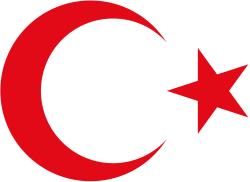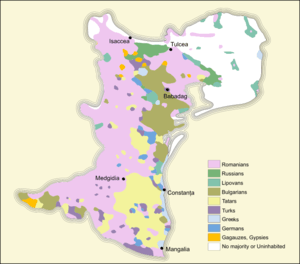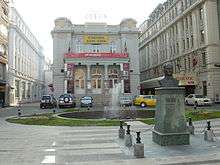Turks of Romania
The Turks of Romania, also known as Romanian Turks, (Turkish: Romanya Türkleri, Romanian: Turcii din România) are ethnic Turks who form an ethnic minority in Romania. According to the 2011 census, there were 28,226 Turks living in the country, forming a minority of some 0.15% of the population.[1] Of these, 81.1% were recorded in the Dobruja region of the country's southeast, near the Black Sea, in the counties of Constanța (21,014) and Tulcea (1,891), with a further 8.5% residing in the national capital Bucharest (2,388).[4]
| Total population | |
|---|---|
| 28,226 (2011 census)[1] est. 55,000[2] to 80,000[3] | |
| Regions with significant populations | |
| Languages | |
| Religion | |
| Islam |
.png)
| Part of a series of articles on |
| Turkish people |
|---|
 |
|
|
|
History
Turkic settlement has a long history in the Dobruja region, various groups such as Bulgars, Pechenegs, Cumans and Turkmen settling in the region between the 7th and 13th centuries, and probably contributing to the formation of a Christian autonomous polity in the 14th century. An important event in the history of the Turkish population was however the Ottoman conquest of the region in the early 15th century. Hence, by the 17th century most of the settlements in Dobruja had Turkish names, either due to colonisations[5] or through assimilation of the Islamised pre-Ottoman Turkic populations. In the nineteenth century, Turks and Tatars were more numerous in Dobruja than the Romanians.[6]

| Demographic history in Dobruja | |||||||||
| Ethnicity | 1880[7] | 1899[7] | 1913[8] | 19301[9] | 1956[10] | 1966[10] | 1977[10] | 1992[10] | 2002[10] |
|---|---|---|---|---|---|---|---|---|---|
| All | 139,671 | 258,242 | 380,430 | 437,131 | 593,659 | 702,461 | 863,348 | 1,019,766 | 971,643 |
| Romanian | 43,671 (31%) | 118,919 (46%) | 216,425 (56.8%) | 282,844 (64.7%) | 514,331 (86.6%) | 622,996 (88.7%) | 784,934 (90.9%) | 926,608 (90.8%) | 883,620 (90.9%) |
| Bulgarian | 24,915 (17%) | 38,439 (14%) | 51,149 (13.4%) | 42,070 (9.6%) | 749 (0.13%) | 524 (0.07%) | 415 (0.05%) | 311 (0.03%) | 135 (0.01%) |
| Turkish | 18,624 (13%) | 12,146 (4%) | 20,092 (5.3%) | 21,748 (5%) | 11,994 (2%) | 16,209 (2.3%) | 21,666 (2.5%) | 27,685 (2.7%) | 27,580 (2.8%) |
| Tatar | 29,476 (21%) | 28,670 (11%) | 21,350 (5.6%) | 15,546 (3.6%) | 20,239 (3.4%) | 21,939 (3.1%) | 22,875 (2.65%) | 24,185 (2.4%) | 23,409 (2.4%) |
| Russian-Lipovan | 8,250 (6%) | 12,801 (5%) | 35,859 (9.4%) | 26,210 (6%)² | 29,944 (5%) | 30,509 (4.35%) | 24,098 (2.8%) | 26,154 (2.6%) | 21,623 (2.2%) |
| Ruthenian (Ukrainian from 1956) |
455 (0.3%) | 13,680 (5%) | 33 (0.01%) | 7,025 (1.18%) | 5,154 (0.73%) | 2,639 (0.3%) | 4,101 (0.4%) | 1,465 (0.1%) | |
| Dobrujan Germans | 2,461 (1.7%) | 8,566 (3%) | 7,697 (2%) | 12,023 (2.75%) | 735 (0.12%) | 599 (0.09%) | 648 (0.08%) | 677 (0.07%) | 398 (0.04%) |
| Greek | 4,015 (2.8%) | 8,445 (3%) | 9,999 (2.6%) | 7,743 (1.8%) | 1,399 (0.24%) | 908 (0.13%) | 635 (0.07%) | 1,230 (0.12%) | 2,270 (0.23%) |
| Roma | 702 (0.5%) | 2,252 (0.87%) | 3,263 (0.9%) | 3,831 (0.88%) | 1,176 (0.2%) | 378 (0.05%) | 2,565 (0.3%) | 5,983 (0.59%) | 8,295 (0.85%) |
Demographics


The majority of Turks live in the historical region of Northern Dobruja (Turkish: Dobruca), particularly in Constanța County, where they number 21,014 and make up 3.3% of the population, Tulcea County with 1,891 (0.94%) and Bucharest with 2,388 (0.14%). Dobromir, a commune in Constanța County, is the only one in Romania with a Turkish majority (61.93%). As an officially recognised ethnic minority, Turks have one seat reserved for them in the Romanian Chamber of Deputies, which has been held by the Democratic Turkish Union of Romania since 1992. An important Turkish community also used to live until 1970 on the island of Ada Kaleh.
After 1989, a significant number of Turkish entrepreneurs started investing and establishing business ventures in Romania, and a certain proportion chose to take up residence in Romania. Unofficial sources estimate there are 12 thousand Turkish citizens in Bucharest.[11]
Notable people
- Fedbi Osman, President of Democratic Turkish Union of Romania (1994-1997, 2004-present), engineer, member of the chamber of deputies (1996-2000)[13], county councilor of Constanța (2004-2008, 2008-2012, 2012-2016)[14], director of the "Hakses" publication ("The Voice of Hope")
- Secil Cantaragiu, Turkish politician
- Kazak Abdal, Ottoman poet
- Nejla Ateş, Belly dancer
- Mehmet Rüştü Bekit, Turkish politician
- Aylin Cadîr, actress and singer
- Harun Osman, Turkish politician
- Hamdi Cerchez, actor
- Ömer Cerrahoğlu, Gold medal winner of the International Mathematical Olympiad
- İbrahim Hilmi Çığıraçan, Turkish writer
- Elena Farago, Poet
- Kemal Karpat, Turkish historian
- Rıza Saltuğ, Turkish politician
- Sevil Shhaideh, Politician
- Numan Ustalar, Turkish politician
See also
References
- National Institute of Statistics 2011, 10.
- Phinnemore 2006, 157.
- Constantin, Goschin & Dragusin 2008, 59.
- National Institute of Statistics 2011, 6.
- Brozba 2010, 48
- Boia 2001, 20.
- G. Dănescu, Dobrogea (La Dobroudja). Étude de Géographie physique et ethnographique
- Roman, I. N. (1919). "La population de la Dobrogea. D'apres le recensement du 1er janvier 1913". In Demetrescu, A (ed.). La Dobrogea Roumaine. Études et documents (in French). Bucarest. OCLC 80634772.
- Calculated from results of the 1930 census per county, taken from Mănuilă, Sabin (1939). La Population de la Dobroudja (in French). Bucarest: Institut Central de Statistique. OCLC 1983592.
- Calculated from statistics for the counties of Tulcea and Constanţa from "Populaţia după etnie la recensămintele din perioada 1930–2002, pe judete" (PDF) (in Romanian). Guvernul României — Agenţia Naţională pentru Romi. pp. 5–6, 13–14. Retrieved 2007-05-02.
- Turci at Noile minorități din București
- Romanian Census 2011
- "Activitate parlamentară Fedbi Osman".
- "Activitate CJC Fedbi Osman".
Bibliography
- Brozba, Gabriela (2010), Between Reality and Myth: A Corpus-based Analysis of the Stereotypic Image of Some Romanian Ethnic Minorities, GRIN Verlag, ISBN 3-640-70386-3.
- Constantin, Daniela L.; Goschin, Zizi; Dragusin, Mariana (2008), "Ethnic entrepreneurship as an integration factor in civil society and a gate to religious tolerance. A spotlight on Turkish entrepreneurs in Romania", Journal for the Study of Religions and Ideologies, 7 (20): 28–41
- National Institute of Statistics (2002), Population by ethnic groups, regions, counties and areas (PDF), Romania - National Institute of Statistics
- National Institute of Statistics (2011), Comunicat de presă privind rezultatele provizorii ale Recensământului Populaţiei şi Locuinţelor – 2011 (PDF), Romania-National Institute of Statistics
- Phinnemore, David (2006), The EU and Romania: Accession and Beyond, The Federal Trust for Education & Research, ISBN 1-903403-78-2
External links
| Wikimedia Commons has media related to Turks in Romania. |